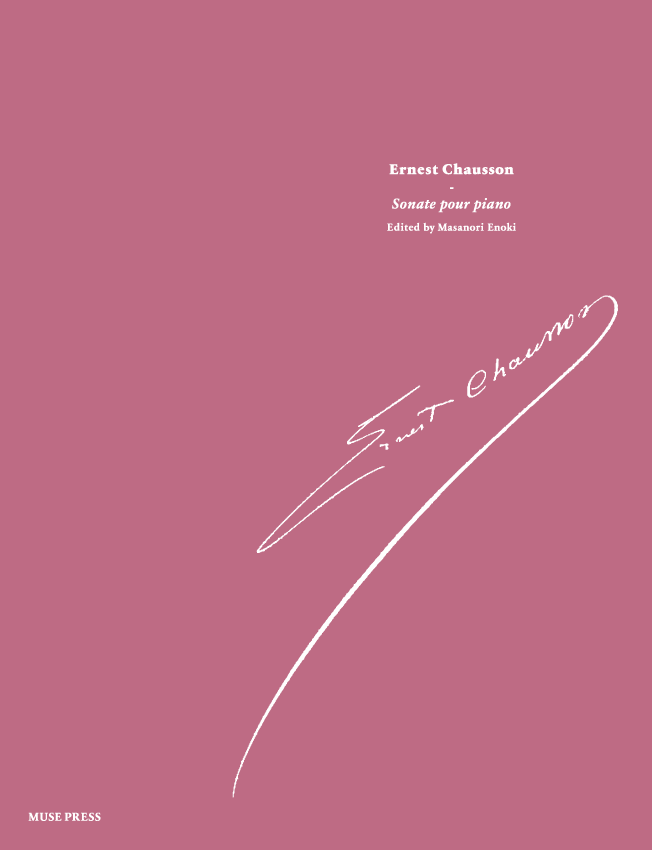We are pleased to announce our new publications in July 2021.
Ernest Chausson: Sonate pour piano
“Sonate pour piano” was composed by the French composer Ernest Chausson the year after he entered the Paris Conservatoire. For many years the manuscript of this work was in the possession of the Bibliothèque Nationale de France, but for some reason it has never been published. For this publication, Masanori Enoki, a composer, pianist and graduate of the Paris Conservatoire, has revised and commented on this work. This work is strongly influenced by Beethoven and Schubert, and has a very different expression to Chausson’s music as we know today. The theme of the third movement is also used in his clarinet and piano work “Andante et Allegro”.
Richard/Strauss: Till Eulenspiegels lustige Streiche (Concert Transcription for piano)
The German-born French pianist Édouard Risler arranged Richard Strauss’s late 19th century symphonic poem “Till Eulenspiegels lustige Streiche” for solo piano. The leading French pianist of the time, Alfred Denis Cortot, was also greatly influenced by Risler. The works of Richard Strauss could not be published in Europe until 2020 due to copyright laws. When the Italian pianist and composer Francesco Libetta performed this arrangement at the Festival de La Roque-d’Anthéron, many people became aware of its existence and demanded its publication. This edition includes a commentary not only by Libetta but also by Dan Sato.
Excerpt from the foreword by Francesco Libetta
The path of his musical life is well-recognizable in the piano version of the score of Till Eulenspiegel. In Risler’s version, the intricate polyphony in Strauss’ score is meticulously reproduced on the keyboard, presupposing in the performer an extraordinary technique of digital independence. The sound masses are practically never recreated through the means of the piano’s free resonances; the octaves are intended to be very rapid, Saint-Saëns style (in fact, Risler also transcribed for two pianos some of his Études). Finding the indispensable timbral colors thus becomes an inordinately demanding task. If the sound masses heard in the orchestral version cannot rely on long piano pedals, which would prevent the necessary polyphonic clarity, the resulting demand for every single finger must be extreme. The number of notes to be played very quickly could force even the most experienced pianists to slow down tempi unnaturally. Moreover, Risler often prescribes large and risky leaps that are fundamental to the understanding of the harmonic discourse, and such gestures cannot be performed with prudence (that is, by slowing down) without the expression or the musical atmosphere being deeply suffocated. For the music’s full potential to be heard and understood, Risler’s transcription requires, in short, such cold-bloodedness and control of every musical parameter that, as is evident, generations of virtuosi have kept away from it. Risler’s manuscript was never published; annotated in pencil, with afterthoughts and corrections, it sat on the shelves of the National Library of France in Paris, protected by the rights on Strauss’ compositions, and remained a legend.
Walter Gieseking: Chaconne (über ein Thema von Scarlatti)
Walter Gieseking’s Chaconne on a Theme by Scarlatti was composed on board the Hamburg-Amerikanische Packetfahrt-Actien-Gesellschaft’s ship “New York”, which Gieseking used on his tour from Germany to the North American continent. The German pianist Joseph Moog has recently released a CD containing this work on Onyx, but the score has only been privately published by Pelisorious Editions in Portland, Oregon. This edition has been carefully revised and annotated by the musicologist Satoru Takaku, and is now officially published. Due to copyright reasons, this work can only be shipped to certain countries.
Saburo Moroi: Piano Sonata C-major No. 1, Op. 5
We have been publishing the works of Saburo Moroi continuously for several years, and now we are pleased to add the Piano Sonata C-major No. 1 Op. 5 to our catalogue. Saburo Moroi wrote about ten piano sonatas, and according to the new work numbering system which he later adopted, this work is listed as “Op. 5”. There are only two piano sonatas that appear within the new opus numbering system, including this one. The sonata was composed during his studies in Berlin. It takes about half an hour to perform and was the longest piano sonata written by a Japanese composer at the time.



